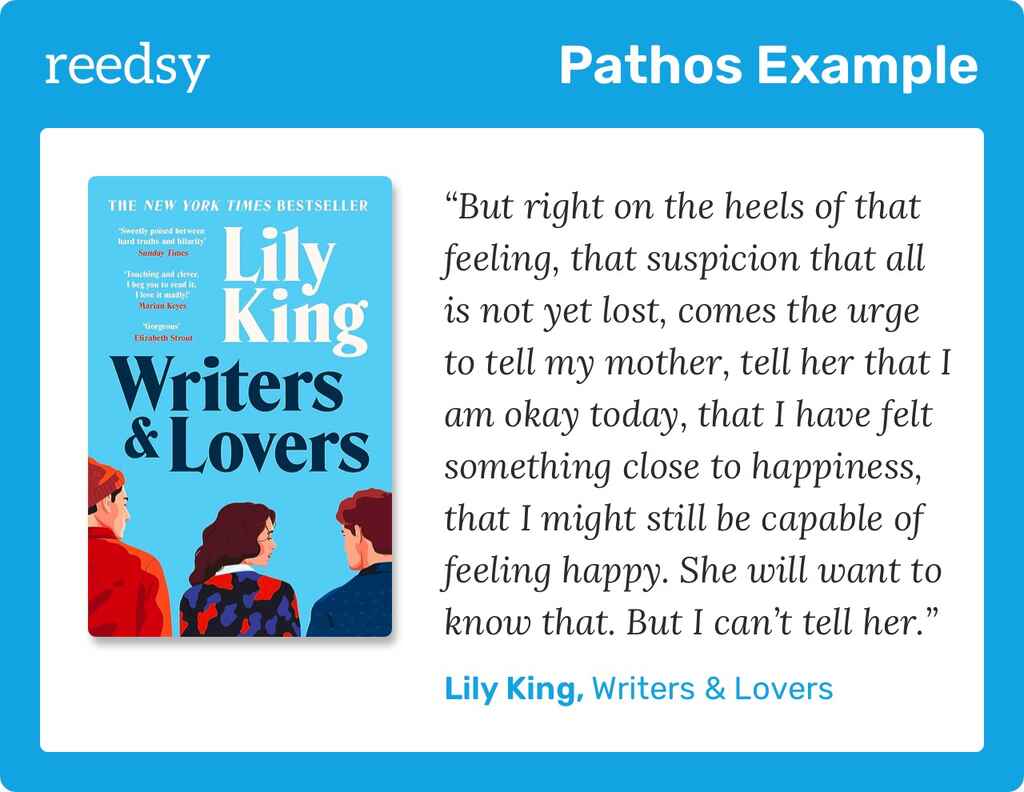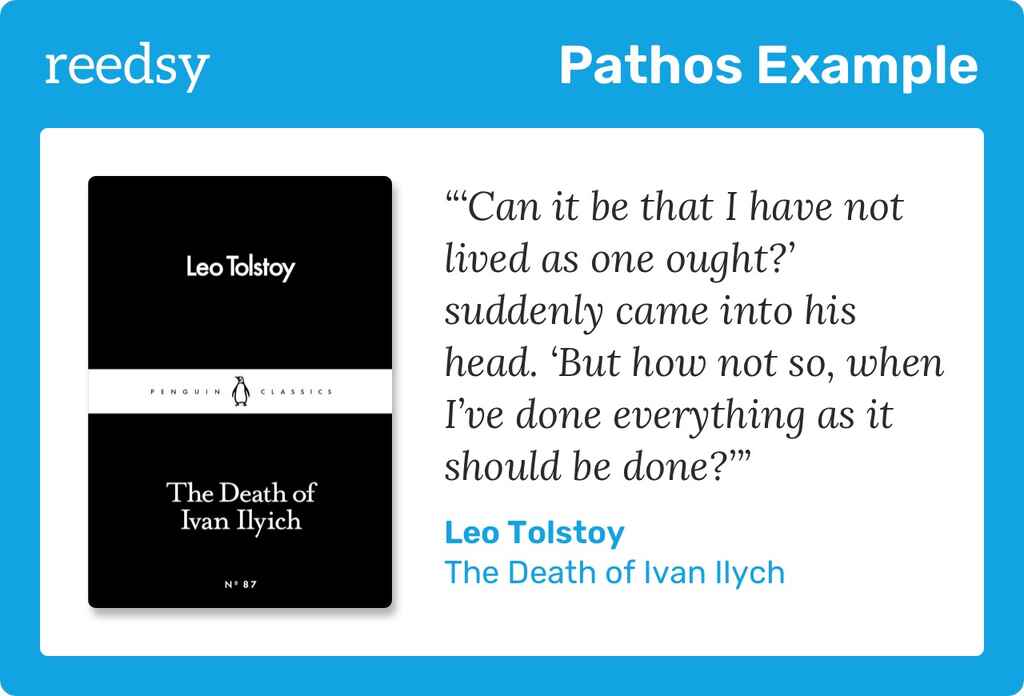Posted on Sep 29, 2023
What is Pathos? Definition and Examples in Literature
Pathos is a literary device that uses language to evoke an emotional response, typically to connect readers with the characters in a story. The emotions associated with pathos in literature include sympathy, compassion, sadness, and occasionally, anger.
The most obvious examples of pathos can be found in tragic narratives where characters’ fates take a dramatic turn for the worse. However, this device also subtly appears in virtually every story that features a negative plot development.
Let’s take a look at the origins of the term and how it can be used to achieve different effects in books.
Pathos persuades by appealing to emotion
Pathos taps into our most primal behavioral responses, making us feel things. As well as a way to appeal to readers’ emotions in literature, it is known as one of the three rhetorical modes of persuasion, along with ethos and logos. All three are outlined in Aristotle’s Rhetoric as ways to appeal to an audience and convince them that the point you’re making has credibility.
- Pathos appeals to the audience’s sense of compassion
- Ethos appeals to their sense of right and wrong
- Logos appeals to their logic
It’s not hard to see why pathos can persuade. Let’s say you’re trying to illustrate how significant clinical depression is. The following two statements would affect your audience in very different ways:
- 18.4% of U.S. adults reported having been diagnosed with depression before, according to a 2020 study.
- “I have no energy, feel drained, and have no interest in anything,” says Steven, who has recently been diagnosed with depression — every sleepless night, he battles the overpowering feeling of self-hatred.
Statistics rarely lie, but they are hard to relate to. A single individual’s struggles, however, are something everyone can imagine themselves facing.
Pathos as a device appears in rhetoric, literature, and other kinds of writing, like politicians' speeches, but in the rest of this post, we’ll focus on pathos as a literary device in a few novels, novellas, and plays. It’s helpful to remember that pathos was originally a persuasive technique — when you encounter it in books, films, and TV shows, you can take a step back and ask yourself what the writer is trying to show you.
💡Note that the adjective for language that uses pathos is “pathetic.” In a piece of criticism, if a character is described as a “pathetic figure,” the writer isn’t saying they are a miserable loser. Rather, the audience feels for their suffering.

FREE RESOURCE
Literary Devices Cheatsheet
Master these 40+ devices to level up your writing skills.
Let’s now take a look at a few different examples of pathos from literature to demonstrate the many ways in which pathos can be used to “persuade” an audience’s feelings one way or another.
It raises the stakes of a story
In tragedies, things must, by definition, go badly — leading to inevitable pathos. Classical tragedies (which follow Freytag’s pyramid structure) create tension by escalating dramatic events beyond the point of no return, maximizing the stakes as the reader or audience becomes more invested in what happens to the characters.
Take a look at Shakespeare’s Romeo and Juliet as an example, with its famous family vendetta preventing the two protagonists from marrying with the approval of their families. As the play progresses, more and more devastating developments pose obstacles in the couple’s way.
“Shall I speak ill of him that is my husband?
Ah, poor my lord, what tongue shall smooth thy name,
When I, thy three-hours wife, have mangled it?
But, wherefore, villain, didst thou kill my cousin?
That villain cousin would have kill’d my husband:
Back, foolish tears, back to your native spring;
Your tributary drops belong to woe,
Which you, mistaking, offer up to joy.”
— Juliet in William Shakespeare’s Romeo and Juliet

At a critical point in the play, Romeo (who has recently married Juliet in secret) avenges his friend Mercutio’s death by killing Juliet’s beloved cousin Tybalt. When Juliet learns this news, the audience sees her battle conflicting emotions:
- grief for her cousin
- anger toward Romeo
- compassion because she knows that Tybalt would not have hesitated to kill Romeo
- anger toward herself for not being fully on her husband’s side
We know that Juliet is in an impossible situation through no fault of her own, and the fact that Romeo has killed her cousin irrevocably rules out the possibility that their families will reconcile — the stakes, in other words, are higher than ever, and the play reaches its climax.
There is no way out for Juliet, as all options lead to someone’s betrayal or disappointment. This emotional escalation heightens tension, and structurally signals that the play is snowballing toward its tragic conclusion. Used in this way, pathos delineates the exact point where things get completely out of control, upping the stakes.

FREE RESOURCE
Three Act Structure Template
Craft a satisfying story arc with our free step-by-step template.
Of course, the stakes are raised because the audience’s compassion for the main characters is elevated to a new level, which is one of the most powerful effects pathos can create.
It gets readers to sympathize with fictional characters
By definition, pathos tugs at the reader’s heartstrings. When we feel bad for a character’s predicament, we tend to side with them and hope their situation improves.
Take Barbara Kingsolver’s Demon Copperhead, a modern-day retelling of Charles Dickens’ David Copperfield. The novel’s protagonist, Demon, is an orphan growing up in addiction-stricken rural Appalachia. Told from Demon’s point of view as a child, the book doesn’t often explicitly reflect on his emotions — instead, readers see him as a boy of action, someone for whom practical difficulties leave little room for him to feel sorry for himself. The rare reflective moments readers are privy to take on even greater significance, showing that behind Demon’s confident behavior lie the broken heart and sharp mind of a boy who is conscious of the discomfort other people feel around him.
"Once on a time I was something, and then I turned, like sour milk. The dead junkie's kid. A rotten little piece of American pie that everybody wishes could just be, you know. Removed."
— Demon in Barbara Kingsolver's Demon Copperhead

How can readers not feel for a young boy so devastatingly aware of the fact that his existence is an inconvenience to many although he has done nothing wrong? Moments of acute pathos such as these make readers care deeply about Demon, whose intelligence and vulnerability become even more evident.
For writers, Demon Copperhead provides a masterclass in characterization. Demon is a flawed character and makes his fair share of mistakes, but when readers see his core need to be loved go so woefully unmet in his early years, they want to know where his story goes next. As Tom Bromley (author, ghostwriter, and head instructor of Reedsy’s three-month course, How to Write a Novel) points out, creating characters readers care about, as opposed to perfectly likable ones, lends substance and complexity to a story, so don’t let your characters suffer from what Tom calls “nice person syndrome.” Prioritize creating space for empathy, not flawless likeability.

NEW REEDSY COURSE
How to Write a Novel
Enroll in our course and become an author in three months.
In addition to caring more deeply for characters, pathos can help us understand them better.
It contextualizes character behavior
Backstory plays a massive role in determining how characters are received by readers. We all carry our pasts, and fictional characters are no different: their pasts continue to affect them, and knowing where they’re coming from can help us understand their behavior.
In Lily King’s Writers & Lovers, the narrator is a 31-year-old woman named Casey Peabody who has recently lost her mother. The book is not about her mother’s death — instead, it describes Casey’s ongoing financial struggles, writerly anxieties, and inability to choose and commit to a romantic partner. Remembering that the loss of her mother lingers in Casey’s thoughts every day helps readers contextualize her emotions and actions.
“But right on the heels of that feeling, that suspicion that all is not yet lost, comes the urge to tell my mother, tell her that I am okay today, that I have felt something close to happiness, that I might still be capable of feeling happy. She will want to know that. But I can’t tell her.”
― Lily King, Writers & Lovers

In the extract above, Casey shares that she feels better than usual, but this feeling is bittersweet since she cannot talk to her mother about her improving emotional state. As readers, we feel for Casey, who is left unable to make active decisions.
Her reluctance to commit to one of two romantic interests, for example, isn’t as puzzling when readers are reminded that she constantly feels like she is losing control of her life.

FREE COURSE
How to Develop Characters
In 10 days, learn to develop complex characters readers will love.
After all, understanding a character brings about increased empathy and helps reinforce a book’s central themes.
It reinforces a book’s central themes
In the same way that Lily King’s novel thematizes grief and coming of age, every work of literature arguably has some key threads that run through its narrative, and instances of pathos help bring these themes to the forefront.
In Tolstoy’s novella The Death of Ivan Ilych, an ill and dying man slowly realizes his life was wastefully spent in pursuit of the wrong things. Tolstoy returns to the themes of morality and death again and again, asking readers what it means to live a good and meaningful life.
After briefly describing a scene from Ivan Illych’s funeral, the book takes readers into his past, showing that he didn’t set out to be bad — he just prioritized what was valued in society. However, as Ivan nears death, he is hit by a terrible realization:
“‘Can it be that I have not lived as one ought?’ suddenly came into his head. ‘But how not so, when I’ve done everything as it should be done?’”
— Leo Tolstoy, The Death of Ivan Ilych
 Here, Ivan comes to the key realization at the heart of Tolstoy’s book: what “should be done” by society’s standards of living well doesn’t necessarily help build a good and meaningful life.
Here, Ivan comes to the key realization at the heart of Tolstoy’s book: what “should be done” by society’s standards of living well doesn’t necessarily help build a good and meaningful life.
The entire novella hinges on this moment of staggering realization and pathos for its protagonist, and its readers can see the tremendous implications this has: Ivan cannot live his life again and make better choices. He’s stuck with the life he has lived, which is nearly over.
In this pathetic scene, the book’s themes are very painfully reinforced, showing readers that making moral choices is an urgent and pressing issue, with Ivan serving as a reminder that time is running out for all of us. If readers felt no sympathy for Ivan, the book would be dramatically less powerful — so pathos is key here.
✅
Test your theme-detecting skills!
See if you can identify five themes from five questions. Takes 30 seconds!
By strengthening themes, pathos can also serve to immerse readers in the mood of a literary work.
It immerses readers in the mood of the writing
When you finish reading a book, what feelings do you come away with? The answer to this question summarizes the book’s overarching mood — which might be, for example, one of hope, depression, apathy, or regret.
When pathos is used, the mood often darkens. With his 19th-century novel The Nether World, George Gissing wanted to highlight the plight of the working class to middle-class readers. Therefore, his book emphasizes the contrast between the beautiful, sunny English countryside and the bleakness of a working-class neighborhood in London:
“At noon to-day there was sunlight on the Surrey hills; the fields and lanes were fragrant with the first breath of spring, and from the shelter of budding copses many a primrose looked tremblingly up to the vision of blue sky. But of these things Clerkenwell takes no count; here it had been a day like any other, consisting of so many hours, each representing a fraction of the weekly wage. Go where you may in Clerkenwell, on every hand are multiform evidences of toil, intolerable as a nightmare.”
― George Gissing, The Nether World
Gissing begins by showing readers beauty before quickly ripping it away, leaving them in a place that is the polar opposite of the Surrey hills. The sharp contrast between the two is incredibly pathetic and shows the overarching mood of the novel to be one of disillusionment and gloom. By zooming in on the impoverished workers of London, Gissing sheds light on the misery and struggles prevalent in the city. He also shows how unnecessary and merciless it seems in the context of the wider natural world.
📚 Got gaps in your reading? Check out our list of 100 must-read classic books.
By using pathos to insist on this mood of gloom and despair, Gissing “persuades” his readers that a better world should be possible. But pathos isn’t just about making readers passively react to something — it can also be used to spur them into action, or to create a sense that something must and will change.
Pathos can signal imminent change

When used consecutively, plot points that evoke pathos will escalate tension, contributing to a story’s rising action. In time, this leads to an emotional climax in the protagonist’s journey.
In Gustave Flaubert’s Madame Bovary, the novel’s titular character longs for a life of luxury and romance — a dream that’s stymied by her marriage to a middle-class health worker. Growing more and more bored by the day, she eventually becomes listless and desperate for change.
“At the bottom of her heart, however, she was waiting for something to happen. Like shipwrecked sailors, she turned despairing eyes upon the solitude of her life, seeking afar off some white sail in the mists of the horizon. She did not know what this chance would be, what wind would bring it her, towards what shore it would drive her, if it would be a shallop or a three-decker, laden with anguish or full of bliss to the portholes. But each morning, as she awoke, she hoped it would come that day; she listened to every sound, sprang up with a start, wondered that it did not come; then at sunset, always more saddened, she longed for the morrow.”
― Gustave Flaubert, Madame Bovary
These details of Emma Bovary’s desperate hope for a change in her life appeal to the readers’ emotions. Though the pathos in her situation stems from the lack of action in her life, as opposed to a disastrous event, we still feel for her because we see how isolated she feels from her husband and how she struggles to accept her reality.
Readers witness Emma’s dejected state and empathize with her. Suddenly, we feel what Emma feels: that things have to change. That means that when change does arrive, we’re both prepared and relieved.
Though a simple literary device, pathos can take many forms. Hopefully, now that you’ve joined us in studying some of its manifestations, you’ll encounter it with greater awareness the next time you read a book. Just ask yourself: what’s the author persuading me to feel?
Want to brush up on more literary techniques? Head to our comprehensive list of 60+ literary devices next.








